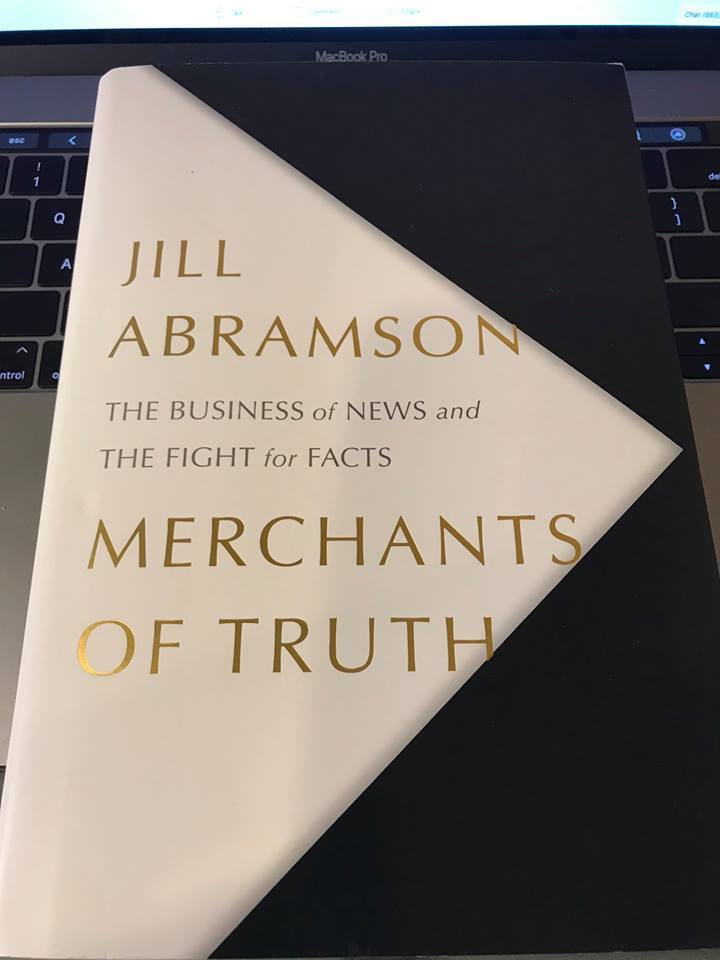By Jill Abramson.
Review Alagi Yorro Jallow‧

Fatoumatta: I highly recommend this excellent book to all Gambian journalists and media practitioners. Highly readable textbook with a combination of essential topics, in-depth reporting, endlessly fascinating anecdotes, and vivid writings. Ms. Jill Abramson’s first female editor in chief of the New York Times in 100 years, was a respected journalist and editor at the venerable New York Times. Merchants of Truth, in its frankness, is an essential read, and its skewering of journalism’s leaders earned Abramson some new enemies and provoked old ones.
However, it is unlikely that a woman with balls like iron cantaloupes will care about that as long as she sounds the alarm. The book Merchants of Truth was supposed to be an ode to ethical, unyielding, and importantly, original journalism and news reporting. The former executive editor of the New York Times examines how and why American journalism has changed drastically in the past decade and what those changes mean for an informed citizenry. In “Merchants of Truth: The Business of News and the Fight for Facts,” Abramson shows that she is not only up to the challenge but that her travails in the rapid and unrelenting evolution of mass communication gave her the motivation and perspective to tell the story of how the pressures of the modern age are eroding — yet, in some distinct ways, elevating — the standards of journalism.
Fatoumatta: In “Merchants of Truth,” Abramson leaves no doubt about her discomfort with the disruptions to her chosen profession. She notes that it was not so long ago that a top-level Times editor would object to an advertising executive even crossing the sacred ground of the newsroom to speak with him. Now, she reports, the insulation of the news coverage from business concerns is less rigid.”Merchants of Truth” is a fascinating read. Still, even an undertaking of this ambition cannot fully capture the tectonic shifts in the news media in the past decade. For example, only one of the 13 chapters is devoted to the Facebook factor, which revolutionized information consumption — in an algorithm-driven system that proved vulnerable to manipulation.
Moreover, by focusing on four prominent organizations, the book gives barely more than a passing mention to one of the most insidious trends in media: the swallowing of local journalism by craven chains that are openly peddling political ideology, eviscerating newsrooms for the sake of profits.
Fatoumatta: Abramson says we are living through journalism’s “Age of Anxiety” and makes a convincing and often distressing case for the premise. The uplifting takeaway from her book is that anxiety does not necessarily foretell a cataclysm. For at least the Times and the Post, the billionaires who came to their rescue came through with promised resources and a commitment to quality, without an apparent ulterior agenda. The president’s trashing of those and other respected news organizations has alerted the public to their importance and boosted their audiences. The story continues to evolve. Abramson notes that 60 percent of newspaper jobs have disappeared since 2000, and more than 300 papers have gone out of business. The digital upstarts that once seemed ascendant also are encountering a grim reality. BuzzFeed laid off 15 percent of its staff in the past couple of weeks, and Vice let go of 10 percent of its workforce. The anxiety endures.
Fatoumatta: Better than many in her business, Abramson (The Puppy Diaries: Raising a Dog Named Scout, 2011, etc.) understands the roiling craft of journalism from the inside. Refreshingly, she writes candidly about her complicated role in the tsunami of change washing over the industry. In 1979, prominent journalist David Halberstam published The Powers That Be, which looked at a then-turning point in American news media, specifically as related to the Washington Post, Los Angeles Times, New York Times, CBS News, and Time Inc. Abramson notes that Halberstam’s book influenced her to choose journalism as a career. Now she has adopted Halberstam’s structure to drive her latest work. To illuminate the current big picture, the author focuses on four news outlets: the New York Times, Washington Post, BuzzFeed, and Vice Media. She examines these contemporary news organizations at three different intervals since the financial meltdown of 2008.
The fifth presence looming over the narrative is Facebook—and its billions of users. As Abramson delves into the Washington Post, one of the surprising positive elements (in a sea of negatives) is the ownership of Jeff Bezos. Their substantial cash infusions have brought growth, quality, and hope to the newsroom.
Fatoumatta: Regarding her beloved New York Times, Abramson offers a cautionary tale, but she understands that the newspaper, in print and online, still sets the standard of quality in many ways. As for BuzzFeed’s transformation from a lighthearted digital playground to a severe news presence. On the other hand, Vice comes in for harsher treatment, primarily due to founder Shane Smith’s refusal to truly understand the news and his oversight of a misogynistic culture.
The author deftly weaves in important information about Breitbart, the Drudge Report, and other relevant outlets. A highly readable combination of an important topic, in-depth reporting, endlessly fascinating anecdotes, and vivid writing.



